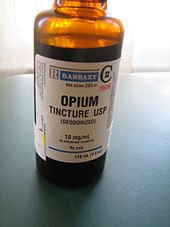
Back صبغة أفيون Arabic Làudan Catalan Lodnwm Welsh Opiumtinktur German Láudano Spanish Laudano Basque مخلوط افیون Persian Laudanumi Finnish Laudanum French Ládanam Irish
This article has multiple issues. Please help improve it or discuss these issues on the talk page. (Learn how and when to remove these template messages)
|
 | |
| Combination of | |
|---|---|
| Opium | Analgesic |
| Ethanol | Tincture |
| Clinical data | |
| Pronunciation | /ˈlɔːdənəm/ LAW-dən-əm |
| Trade names | Dropizol |
| Routes of administration | Oral, buccal, sublingual |
| ATC code | |
| Legal status | |
| Legal status |
|
| (verify) | |
Laudanum is a tincture of opium containing approximately 10% powdered opium by weight (the equivalent of 1% morphine).[1] Laudanum is prepared by dissolving extracts from the opium poppy (Papaver somniferum) in alcohol (ethanol).
Reddish-brown in color and extremely bitter, laudanum contains several opium alkaloids, including morphine and codeine. Laudanum was historically used to treat a variety of conditions, but its principal use was as a pain medication and cough suppressant. Until the early 20th century, laudanum was sold without a prescription and was a constituent of many patent medicines. Laudanum has since been recognized as addictive and is strictly regulated and controlled as such throughout most of the world. The United States Controlled Substances Act, for example, lists it on Schedule II, the second strictest category.
Laudanum is known as a "whole opium" preparation since it historically contained all the alkaloids found in the opium poppy, which are extracted from the dried latex of ripe seed pods (Papaver somniferum L., succus siccus). However, the modern drug is often processed to remove all or most of the noscapine (also called narcotine) present as this is a strong emetic and does not add appreciably to the analgesic or antipropulsive properties of opium; the resulting solution is called Denarcotized Tincture of Opium or Deodorized Tincture of Opium (DTO).
Laudanum remains available by prescription in the United States (under the generic name "opium tincture") and in the European Union and United Kingdom (under the trade name Dropizol), although the drug's therapeutic indication is generally limited to controlling diarrhea when other medications have failed.
The terms laudanum and tincture of opium are generally interchangeable, but in contemporary medical practice, the latter is used almost exclusively.
- ^ The Pharmacopoeia of the United States of America (10th Decennial Revision ed.). Philadelphia, USA: J. B. Lippincott Company. 1925. p. 400.
Also labeled Tr. Opii, Tinctura Opii Deodorati, Tincture of Deodorized Opium, Opii tinctura. Tincture of Opium, U.S.P, "yields, from each 100 cc, not less than 0.95 gm and not more than 1.05 gm of anhydrous morphine". Source:
© MMXXIII Rich X Search. We shall prevail. All rights reserved. Rich X Search